Horemheb tomb Saqqara: description, facts, history, photo | Saqqara New Kingdom tombs
4.5 / 5 165 ReviewsAddress
Location: Saqqara necropolis, 20 km South of Giza, Harraniya-Saqqara road
Accessibility
Not wheel chair friendly
Horemheb was commander in chief of the Egyptian armies during the reign of Tutankhamun, 18th Dynasty. After the death of Tutankhamun's successor Ay, Horemheb became the next pharaoh and started the construction of a royal tomb in the Valley of the Kings in Luxor. It is possible that the 1st Pylon and forecourt of his tomb in Saqqara were built only after he had become king: the tomb served ultimately for the burial of his Queen, Mutnodjmet. Her mortal remains and funeral gifts, together with those of a previous wife of Horemheb were discovered in the tomb's main shaft complex, which is 28 meters deep.
The tomb is built and decorated in Amarna-style art and the interior design shows that it was meant to be a funerary temple. The details of this tomb, which is the largest in the New Kingdom Cemetery, are fascinating. At the tomb, visitors can see that the Ureaus, or headdress of the king, was added to depictions of Horemheb after the original reliefs were made to show that he had become King. There are also depictions of Horemheb worshiping Maat, Re-hor-akhty and Thoth, as well as scenes celebrating his military victories. The architectural form of the tomb is strikingly similar to that of a temple, with multiple pylons and courtyards finally leading to the funerary chapels. A mud brick pyramid would originally have stood above the central cult chapel. The remarkable wall reliefs of the inner courtyard show highlights of the general's career and funeral scenes.
The tomb of Horemheb was found by art collectors around 1825. Relief blocks from the tomb were subsequently taken to the Egyptian Museum in Cairo, the National Museum of Antiquities in Leiden and other museums around the world. The tomb was excavated in 1975-1979 by a joint expedition of the Egypt Exploration Society in London and the National Museum of Antiquities in Leiden, under the auspices of the Sumreme Council of Antiquities of Egypt. The forecourt was found in 2004-2005 by the Leiden Museum and Leiden University. The tomb was provisionally restored in the 1980s, when a number of resin casts of various scenes now in different museums were re-instated. It was further consolidated in 2007. And finally open to public in May 2011.
